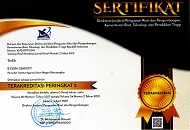THE LEVELS OF QUESTIONS USED ON READING TEST WITH REGARDS TO REVISED BLOOM'S TAXONOMY
Abstract
Keywords
Full Text:
PDF (English)References
Anderson, L. W., & Krathwohl, D. R. (2001). A Taxonomy for Learning, Teaching, and Assessing: A Revision of Bloom’s Taxonomy of Educational Objectives. New York: Longmans.
Banks, S. R. (2012). Classroom Assessment: Issues and Practices. Illinois: Waveland Press.
Bloom, B. S. (1956). Taxonomy of Educational Objectives. United States of America: Longmans.
Brown, H. D. (2007). Principles of Language Learning and Teaching. New York: Pearson Education.
Calmorin, L. P., & Calmorin, M. A. (2007). Research Methods and Thesis Writing. Quezon City: Rex Printing Company, Inc.
Chi Duc, N. (2008). Using Bloom’s Taxonomy to Design in-class Reading Questions for Intermediate Students in the Context of Vietnam. VNU Journal of Science,Foreign Languages, 24, 175–183.
Fiprinita, R. (2007). Types of Question Asked by Teachers in Classroom Interactions. Unpublished Thesis. Padang: Universitas Negeri Padang.
Forehand, M. (2012). Bloom’s Taxonomy: from Emerging Perspectives on learning, Teaching and Technology. Retrieved on January 10th, 2015 at https://www.d41.org/cms/lib/IL01904672/Centricity/Domain/422/BloomsTaxonomy.pdf.
Gall, M. D., & Borg. (2003). Educational Research: An Introduction. Boston: Pearson Education, Inc.
Goodwin, S. . (1992). Effective Classroom Questioning. Urbana-Champaign: office of instructional and managements, University of Illionis.
Karamustafaoğlu, S. (2003). Analysis of Turkish High-School Chemistry-Examination Questions According to Bloom’s Taxonomy. Chemistry Education: Research and Practice, 4(1), 25–30.
Mantyi-Ncube, B., & Hlophe, N. (2011). Teaching Testing Higher Cognitive Skills: A Case of Selected High Schools in Swaziland 10–029/AWB/2011/7–2–63–68. Journal of Agriculture & Social Sciences.
Munzenmaier, C. and N. R. (2013). Bloom’s Taxonomy What’s Old Is New Again. The Learning Guild Research. Retrieved on February 20th, 2014 at http://onlineteachered.mit.edu/edc-pakistan/files/best-practices/session-2/Pre-Session-Munzenmaier-Rubin-2013.pdf.
Pickard, M. J. (2007). The New Bloom’s Taxonomy: An Overview for Family and Consumer Sciences. Journal of Family and Consumer Sciences Education, 25(1).
Richlin, L. (2006). Blueprint for Learning: Constructing College Courses to Facilitate, Assess, and Document Learning. Virginia: Stylus Publishing.
Zimmaro, D. M. (2004). Writing Good Multiple-Choice Exams. The University of Texas. Retrieved on March 12, 2013 at http://www.google.com/url?q=http://www6.cityu.edu.hk/edge/workshop/seminarseries/2010-11/Seminar03-WritingGoodMultipleChoiceExams.pdf.
DOI: http://dx.doi.org/10.31958/jt.v22i1.1421
Refbacks
- There are currently no refbacks.
Copyright (c) 2019 Yenni Kurnia Fitri, Hermawati Syarif, Desvalini Anwar

This work is licensed under a Creative Commons Attribution-NonCommercial 4.0 International License.
TA'DIB with registered number e-ISSN: 2580-2771, p-ISSN: 1410-8208 have been indexed on:

Journal Ta'dib distribute under Lisensi Creative Commons Atribusi-NonKomersial 4.0 Internasional.
Contact us: Ta'dib; Address: FTIK, Universitas Islam Negeri Mahmud Yunus Batusangkar; Jl. Sudirman No. 137 Lima Kaum Batusangkar, Tanah Datar, Sumatera Barat, Indonesia. Email: takdib@uinmybatusangkar.ac.id

























